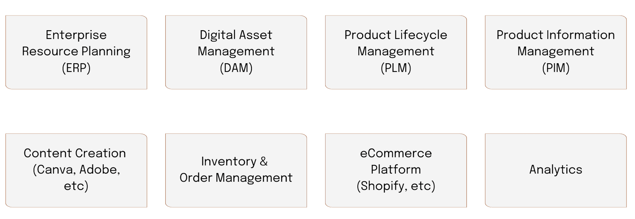8 Essential E-commerce Apps to Elevate Your Online Business
| August 1, 2024

In the world of e-commerce, the success of a brand hinges on more than just the quality of its products. Behind every smooth transaction, every satisfied customer, and every successful marketing campaign lies a complex network of systems operating together in harmony. These systems, when integrated, empower e-commerce brands to operate efficiently, make informed decisions, and provide a seamless shopping experience for their customers.
Even if you know your company would benefit from a new platform it can be hard to know where to start. Since there is a dizzying array of different software types we created a list that not only defines each type but also explains its value and how integration can enhance its functionality in an ecommerce store.
Read on to learn more about these eight different types of e-commerce solutions,

1. Enterprise Resource Planning (ERP)
What It Is and Why It’s Important: ERP’s are a type of software system that enables businesses to integrate various processes, including finance, supply chain, and inventory management, into a single platform. This centralization provides real-time visibility into core business operations, enabling better decision-making, cost control, and resource management.
Integration Importance: When an ERP is integrated with systems like Inventory and Order Management software, e-commerce platforms, and analytics, it ensures that data flows seamlessly across the organization. This means financial records are up-to-date, inventory levels are accurate, and business decisions are based on real-time data, reducing errors and inefficiencies.
2. Digital Asset Management (DAM)
What It Is and Why It’s Important: A DAM system is used to store, organize, and manage digital assets like images, videos, documents, and other media files, making them easily accessible for content creation and distribution. An intuitive interface in a DAM system enhances the user experience by making it easier to manage and navigate digital assets efficiently. For e-commerce brands, consistent, high-quality visuals, whether it be product shots or branding graphics, are key to attracting and engaging customers.
Integration Importance: Integrating DAM with separate platforms, like creative tools and e-commerce platforms, allows for the automatic updating of product images and marketing materials across all channels. This not only saves time but also ensures brand consistency and reduces the risk of outdated or incorrect content being published.
3. Product Information Management (PIM)
What It Is and Why It’s Important: A software platform that centralizes and manages product data, ensuring that accurate and consistent product information is distributed across all sales channels. Consistently accurate product information is crucial for maintaining customer trust and driving conversions in a crowded e-commerce marketplace making the functions of a PIM invaluable. PIM systems can also utilize push notifications to keep teams updated on product information changes.
Integration Importance: When integrated with ERP, e-commerce platforms, and analytics, a PIM system ensures that product information is always up-to-date, accurate, and optimized for searchability. This integration helps streamline product launches and updates, reducing time-to-market and enhancing the customer shopping experience.
4. Product Lifecycle Management (PLM)
What It Is and Why It’s Important: A PLM is a system that manages the entire lifecycle of a product, from initial concept and design through production, distribution, and eventual retirement, often integrating data and processes across different departments. For e-commerce brands, PLM is critical for ensuring that products are developed efficiently, meet quality standards, and comply with regulations. Adobe Commerce can be used in conjunction with PLM systems for better product management.
Integration Importance: Integrating PLM with ERP, PIM, and supply chain management systems allows for a seamless transition from product development to production and market launch. This ensures that all teams have access to the same data, reducing miscommunication and speeding up time-to-market.
5. Content Creation Tools
What It Is and Why It’s Important: High-quality content is essential for engaging customers and differentiating a brand in the e-commerce space. Tools like Canva and Adobe empower teams to efficiently create content in-house versus solely relying on external partners. The Warby Parker app is a prime example of leveraging content creation tools effectively, offering features like Virtual Try-On and extensive frame sorting options.
Integration Importance: When these tools are integrated with DAM and e-commerce platforms, content creation becomes more efficient, with digital assets being readily available for use from within the creative tools themselves. This integration ensures that all content is consistent with brand guidelines and can be quickly deployed across channels.
6. E-commerce Platform (e.g., Shopify)
What It Is and Why It’s Important: An e-commerce platform, like Shopify, is a software solution that allows businesses to create, manage, and operate an online store, handling everything from product listings to payment processing and order fulfillment. Platforms like Shopify provide the infrastructure needed to run an online business, offering flexibility, scalability, and ease of use without the need to build the foundation of an online store from scratch.
Integration Importance: Integrating the e-commerce platform with ERP, PIM, and Inventory and Order Management systems ensures a smooth operation. Orders are processed efficiently, inventory levels are synchronized, and customer data is consistently updated, leading to a seamless shopping experience.
7. Inventory and Order Management
What It Is and Why It’s Important: Effective inventory and order management systems track stock levels, manage orders, and handle fulfillment. For e-commerce brands, this is crucial to avoid stockouts, reduce excess inventory, and ensure that customers receive their orders on time.
Integration Importance: When integrated with ERP, e-commerce platforms, and analytics, these systems provide real-time visibility into inventory levels and order status. This integration enables better demand forecasting, optimized stock levels, and faster order processing, which improves customer satisfaction and reduces operational costs.
8. Analytics
What It Is and Why It’s Important: Analytics tools provide insights into customer behavior, sales trends, marketing performance, and overall business health. For e-commerce brands, data-driven decision-making is essential for optimizing strategies, identifying opportunities, and staying competitive.
Integration Importance: When integrated with ERP, e-commerce platforms, and analytics, these systems provide real-time visibility into inventory levels and order status. This integration enables better demand forecasting, optimized stock levels, and faster order processing, which improves customer satisfaction and reduces operational costs.
For e-commerce brands, success depends on more than just having the right products or marketing strategies. It requires a well-coordinated, efficient operation that can respond quickly to changes, scale with growth, and deliver an exceptional customer experience. While not every type of software is needed for every company, learning about the benefits of each can give you the knowledge and confidence to choose what options will best benefit your brand.
Choosing helpful software is a great start, but integrating platforms to create a cohesive ecosystem is what will ultimately allow you to best meet customer demands, optimize operations, and achieve long-term growth.
Understanding Business Growth
Understanding business growth is crucial for ecommerce businesses to succeed. As an ecommerce business grows, it’s essential to have a scalable ecommerce platform that can handle increased traffic and sales. A growing ecommerce business needs to consider factors such as inventory management, shipping and fulfillment, and customer service. By understanding business growth, ecommerce businesses can make informed decisions about their tech stack, marketing strategies, and customer experience. This ensures that the business can adapt to changing demands and continue to thrive in a competitive market.
Marketing and Sales
Marketing and sales are critical components of ecommerce success. Ecommerce businesses need to have a solid marketing strategy in place to attract and retain customers. This includes using social media, email marketing, and paid advertising to reach potential customers. Additionally, ecommerce businesses need to have a user-friendly interface and an intuitive sales funnel to convert visitors into customers. By leveraging third-party apps and ecommerce platforms, businesses can streamline their marketing and sales efforts and focus on growth. This approach not only helps in acquiring more customers but also in building long-term relationships with them.
Customer Experience
Customer experience is a top priority for ecommerce businesses. A positive customer experience can lead to increased customer confidence, loyalty, and retention. Ecommerce businesses need to focus on creating a seamless and personalized customer experience across all touchpoints, including the online store, customer service, and shipping and fulfillment. By using ecommerce platforms and third-party apps, businesses can create a user-friendly interface and provide a convenient shopping experience for customers. This not only enhances customer satisfaction but also encourages repeat business and positive word-of-mouth referrals.
Security and Compliance
Security and compliance are critical concerns for ecommerce businesses. Ecommerce businesses need to ensure that their online store is secure and compliant with industry regulations, such as PCI compliance and GDPR. By using ecommerce platforms and third-party apps, businesses can ensure that their online store is secure and compliant, and that customer data is protected. Additionally, businesses need to stay up-to-date with the latest security threats and best practices to ensure that their online store is secure and trustworthy. This not only protects the business from potential legal issues but also builds customer confidence in the brand.
For e-commerce brands, success depends on more than just having the right products or marketing strategies. It requires a well-coordinated, efficient operation that can respond quickly to changes, scale with growth, and deliver an exceptional customer experience. While not every type of software is needed for every company, learning about the benefits of each can give you the knowledge and confidence to choose what options will best benefit your brand.
Choosing helpful software is a great start, but integrating platforms to create a cohesive ecosystem is what will ultimately allow you to best meet customer demands, optimize operations, and achieve long-term growth.
